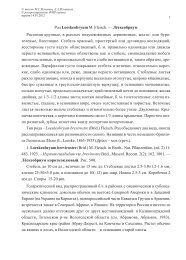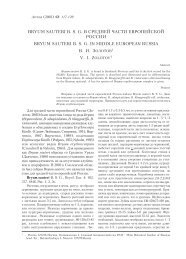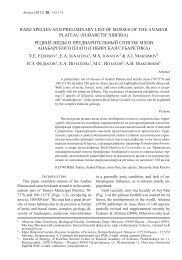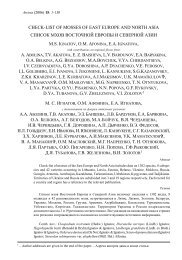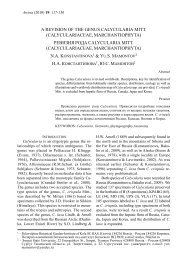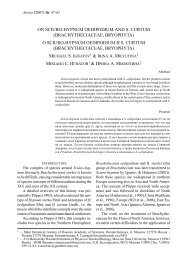THE GENUS BRYUM (BRYACEAE, MUSCI) IN MIDDLE ... - Arctoa
THE GENUS BRYUM (BRYACEAE, MUSCI) IN MIDDLE ... - Arctoa
THE GENUS BRYUM (BRYACEAE, MUSCI) IN MIDDLE ... - Arctoa
Create successful ePaper yourself
Turn your PDF publications into a flip-book with our unique Google optimized e-Paper software.
172<br />
der if present with relatively sudden transition<br />
to laminal cells . . . . . . . . . . 26<br />
26. Leaves distinctly bordered; leaf base red . . 27<br />
– Leaves not or indistinctly bordered; at base<br />
without red color, but sometimes pinkish<br />
throughout . . . . . . . . . . . . . . . 28<br />
27. Plants of wet habitats; tufts to 5(-12) cm<br />
high; leaves widest below the leaf middle,<br />
gradually acuminate, decurrent, border distinct,<br />
4-6-rowed; margin broadly revolute .<br />
. . . . . . . . . . . . B. pseudotriquetrum (p. 208)<br />
– Plants on soil and tree trunks; tufts up to<br />
2.5-3 cm; leaves widest at or above the leaf<br />
middle, contracted into piliferous acumen,<br />
non-decurrent; margin narrowly recurved<br />
. . . . . . . . . . . . . . . . B. capillare (p. 208)<br />
28. Leaves very longly and broadly decurrent<br />
. . . . . . . . . . . . . . . . . . . . . B. weigelii (p. 185)<br />
– Leaves slightly decurrent . . . . . . . . . . . . . . . . .<br />
. . . . . . . . . . . . . . . . B. turbinatum (p. 186)<br />
SPECIES DESCRIPTIONS<br />
Bryum algovicum Sendtn. ex C. Muell., Syn.<br />
Musc. Frond. 2: 569. 1851. Fig. 70<br />
B. angustirete Kindb., Bull. Torrey Bot. Club<br />
16: 94. 1889.<br />
B. pendulum (Hornsch.) Schimp., Coroll.<br />
Bryol. Eur.: 70. 1855. hom. illeg.<br />
Synoicous, rarely some plants within same<br />
tuft male or female. In synoicous inflorescences<br />
antheridia few, perigonia with numerous red<br />
antheridia and paraphyses; paraphyses pale,<br />
about as long as antheridia.<br />
Plants in compact to dense tufts 0.5-1.0 cm<br />
high, yellow-green to brown-green, densely tomentose;<br />
rhizoides orangish-fuscous to redbrown,<br />
+papillose. Stem light to dark red, ca.<br />
0.5 cm long, comose; subterminal shoots 2-4,<br />
comose. Lower leaves ca. 1.5 mm long, 0.5 mm<br />
wide, ovate-lanceolate. Upper leaves erect when<br />
wet, appressed to flexuose or slightly twisted<br />
when dry, (1.8-)2.2-2.5(-2.7) mm long,<br />
(0.5-)0.8(-0.9) mm wide; oblong-ovate to lanceolate,<br />
acuminate, widest at 1/4–1/3 of leaf<br />
length, carinate, non-decurrent, red at base;<br />
margin revolute nearly to apex, entire; border<br />
(2-)4-5(-6)-rowed, indistinctly or distinctly<br />
delimited from lamina; costa stout, red below,<br />
brown-yellow above, excurrent into long smooth<br />
or indistinclty serrulate awn. Laminal cells with<br />
incrassate and slightly porose cell walls; in<br />
V. I. ZOLOTOV<br />
upper leaf rhomboid-hexagonal, 40-60(-64) x 16<br />
μm; in mid-leaf (35-)44-56(-70) x (12-)16(-20)<br />
μm; towards base larger, rectangular, (40-)50-<br />
60(-70) x (16-)20-24(-28) μm, in leaf corners<br />
subquadrate, 32-36 μm, somewhat inflated.<br />
Perichaetial leaves lanceolate, longly acuminate,<br />
margin plane, costa percurrent to shortly<br />
excurrent. Seta 1.5-2.0(-3.0) cm long, brownish<br />
to red, rigid, not twisted when dry, abruptly<br />
curved below capsule. Capsule inclined to pendulous,<br />
brownish to brown or reddish-brown,<br />
below mouth orange to red, 2.5-3(-4) mm long,<br />
1.0-1.5 mm thick, obovate or ellipsoid, not constricted<br />
below a narrow mouth, neck short,<br />
slightly curved. Operculum small, low-conic to<br />
conic, acutely apiculate, brownish, darker than<br />
urn, slightly glossy; often persistent. Annulus<br />
2-4-rowed. Peristome inserted far below mouth,<br />
360-460 μm high. Exostome teeth 100 μm wide<br />
below, tapered from middle into subulate apex,<br />
in lower part reddish- or brownish-yellow, above<br />
yellow and in upormost part hyaline; border<br />
narrow; median line zig-zag-shaped in lower<br />
1/3, straight above; fundus red-orange, 60-70<br />
μm high broadened; ventral lamellae 15-17, with<br />
longitudinal septae at base or nearly throughout,<br />
numerous or few, incrassate or thin. Endostome<br />
adherent to exostome throughout basal<br />
membrane, yellowish; basal membrane 1/3 to<br />
1/2 of endostome heigth; segments narrow, halfsegment<br />
at base 6 to 20 μm wide, narrowly split<br />
along keel; cilia 2-3, reduced or occasionally<br />
better developed and rarely even shortly appendiculate,<br />
densely papillose, papillae +large.<br />
Spores (24-)28(-36) μm, greenish-yellow.<br />
Differentiation and variation: Certain identification<br />
of sterile plants is impossible. The<br />
peristome of this species is one of the most peculiar;<br />
the exostome is adherent to the endostome<br />
throughout the basal membrane (Fig. 000), and<br />
there are numerous longitudinal septae between<br />
the ventral trabeculae. These septae are scattered<br />
from the tooth base upwards, often reaching its<br />
uppermost part. In the lower part of the tooth,<br />
several septae are found between the trabeculae,<br />
creating the appearance of a brick wall. The septae<br />
are usually thick, but in some specimens they<br />
aresparse and rather narrow. Cilia usually are<br />
absent, but exceptionally well-developed and even<br />
shortly appendiculate cilia were found in one<br />
capsule (Tula, Zinger).



